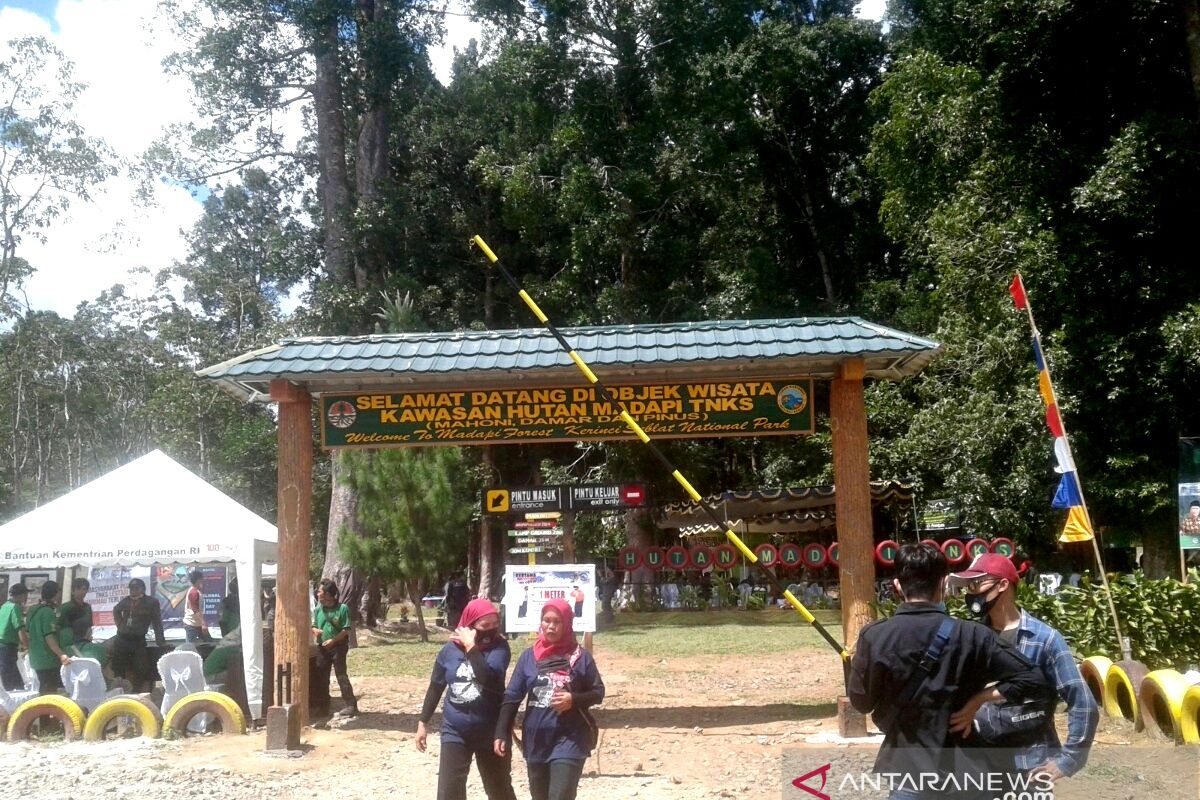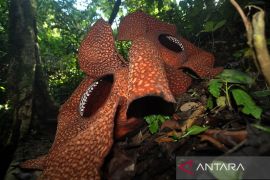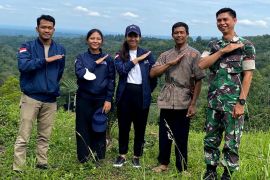The national park was accorded the World Heritage Site status by UNESCO in 2004, as it was home to varied forms of flora and fauna.
The source of threats to the national park vary in the form of illegal loggers seeking high-value logs that grow in it; hunters aiming to catch endemic Sumatran wild animals, such as Sumatran tigers, Sumatran rhinos, elephants, and tapirs; as well as farmers using the land for agriculture and settlement purposes.
Illegal logging occurs when new access roads are opened, thereby enabling easier to-and-fro movement of people. The national park area underwent massive destruction from 2000 to 2005, with many sawmill companies operating along the Sumatra Cross Road and rivers in four provinces.
The national park's destruction gradually subsided after the government stipulated and enforced the law against illegal loggers.
Yet the actions taken by law enforcement officers do not seem to be able to reduce, let alone undo, the damage to the Kerinci Seblat National Park. Destruction of this forest area, which was caused by massive timber extraction, now occurred again due to the conversion of the area to agricultural land and settlements.
Head of the Management Division of the South Sumatra-Bengkulu National Park Region III M Zainuddin remarked that the Kerinci Seblat National Park's area, under his supervision, reaches 598,000 ha, of which some 10 percent had been damaged.
Zainuddin noted that the damage to the national park was generally in areas directly adjacent to settlements. In Bengkulu Province, some 163 villages are located directly adjacent to the Kerinci Seblat National Park that is spread over three districts.
"The entire Kerinci Seblat National Park area, which is directly adjacent to the settlements, is on average, already occupied. Some have become old gardens, while some have new openings. We hope that in future, there would be no new openings," he stated.
He noted that hundreds of villages in Bengkulu Province located directly adjacent to the TNKS area include 26 villages in Rejang Lebong District, 32 villages in Mukomuko District, 105 villages in Lebong District, as well as dozens of other villages in the South Sumatra Province.
Related news: TNKS, BKSDA plan rehabilitation of 6,295 ha forests this year
Economic Empowerment
So far, cases surrounding the Kerinci Seblat National Park area are known to be caused by economic factors, among others. Communities residing in proximity to the national park area become forest loggers or clear land to be used for agricultural purposes due to economic limitations.
It is difficult to find a consensus or solution to the two problems. On one side, the government must enforce the law of forest destruction in cases, while on the other hand, they are just a small community struggling to survive by using the forest resources, as they believe it belongs to God, so they can be enjoyed by anyone.
"If we want to lead a balanced life, we must also pay attention to the environment. Hence, we do not focus on the economy or social aspects, but we also pay attention to the environment. Moreover, this conservation forest is a place to accommodate sources that are the foundation of life for living things," Zainuddin remarked.
To prevent further destruction of the national park area, his administration, along with the national defense force, police force, and the local governments of each region continue to expedite dissemination of information on the importance of preserving the Kerinci Seblat National Park and then conduct joint patrols and economic empowerment of the people living near the area.
Several programs to prevent damage to the national park area have currently been pushed by the Environment and Forestry Ministry, through the Directorate General of Natural Resources and Ecosystem Conservation, and then implemented by the Kerinci Seblat National Park Center. One of the programs is the distribution of economic empowerment assistance for communities around the national park area in the South Sumatra-Bengkulu region.
In 2021, the government had offered capital assistance for goat farming businesses for communities around the national park area. The program is aimed at four farmer groups in the provinces of Bengkulu and South Sumatra. Each group received capital assistance of Rp50 million (US$3,500).
One of the villages receiving goat farming assistance from the Environment and Forestry Ministry is the Gembala Jaya Farmer Group, Karang Jaya Village, Selupu Rejang Sub-district, Rejang Lebong District. This village had earlier also secured a permit from the national park management to use non-timber forest product, that being water, for the provision of clean water to the local village.
In the year prior, the Environment and Forestry Ministry had offered similar economic empowerment assistance to the Rejang Lebong community, especially in two villages in Bermani Ulu Raya Sub-district. The aid recipients were those in the Bandung Marga Village in the form of assistance for cattle farming and those from the Babakan Baru Village for goat farming.
He expects the assistance to be able to drive and improve the income of people around the national park area, so that it would reduce or also stop their mobility to and from the national park area.
Related news: BKSDA proposes widening of wildlife corridor in Seblat
Tourism potential
The national park area possesses extraordinary natural tourism potential apart from its wealth of unique flora and fauna, including the mahogany, resin, and pine tourism forest located in Pal VIII Village, Bermani Ulu Raya Sub-district, Rejang Lebong District.
Visitors keen on the Madapi forest tour are required to pay only Rp 5,000 (less than US$1) and they can enjoy the beautiful scenery created out of the 31 hectares of dense mahogany trees, 21 hectares of resin, 148 hectares of pine, and 10 hectares of candlenut plants.
Another must-visit tourist attraction at the national park area of the Bermani Ulu Raya Sub-district is the Batu Betiang Waterfall, which is located in Merasi Hamlet, Babakan Baru Village, Bermani Ulu Raya Sub-district.
The Batu Betiang Waterfall is located in the Kerinci Seblat National Park area of Rejang Lebong Resort, which is some two kilometers from community settlements. The local community is aware of this waterfall, but the general public had not yet been able to enjoy this hidden gem, as access to it is still in the form of a footpath.
Residents visiting this location are enthralled by the complete package of beautiful scenery, fresh and clear water, and meticulously arranged rock formation that supports the entire waterfall.
The rocks supporting the waterfall, which are neatly arranged to resemble rectangular wooden blocks, are said to have been made by Si Pahit Lidah. He was a legendary figure among the people of Southern Sumatra and had inspired the birth of folklore in South Sumatra, Jambi, Bengkulu, and Lampung.
Related news: Kerinci Seblat potential world birdwatching destination: observer
Law enforcement
Maintaining sustainability of the Kerinci Seblat National Park is the responsibility of every Indonesian citizen. Law should be enforced to prevent damage to the national park area, as one of the efforts apart from persuasive endeavors through outreach programs and community empowerment.
Rejang Lebong Police Chief Adjunct Senior Commissioner Puji Prayitno, through the Rejang Lebong Police Operations Head Adjunct Commissioner Margopo, stated that recently, his side had arrested one encroachment and illegal logging suspect in the national park area in the Duku Ulu Village, Selupu Rejang Sub-district.
This suspect was caught during the 2021 Wanalaga Nala Operation by officers of the local Kerinci Seblat National Park and Natural Resources Conservation Agency in mid to late August of 2021.
"In 2021, during the Wanalaga Nala operation, we managed to (narrow down on) seven people as the perpetrators, but only one person has complete files and is supported by evidence, while the other six people are required to report," he noted.
The case that was forwarded to the public prosecutor was that of forest encroachment in the national park area in the Duku Ulu Village area, Selupu Rejang Sub-district. The suspect, C, 58, a resident of Cawang Village, Selupu Rejang Sub-district, was caught red-handed as he was turning a forest area into a garden.
He was caught during a patrol of the National Forestry Police Section for the Management of National Park Region VI Rejang Lebong along with the Rejang Lebong Police Force. In addition to the suspects, the Kerinci Seblat National Park officers also found pieces of evidence, such as machetes, knife, hammer, and chainsaw.
In 2021, during the Wanalaga Nala Operation, held for 15 days on August 13-28, officers managed to catch seven perpetrators in forestry cases and protected animal ownership. The figure is far more than the target set for only three perpetrators.
Of these seven perpetrators, the officers managed to secure evidence in the form of five cubic meters of unclaimed processed wood of medang type and meranti, which were allegedly the result of illegal logging in the national park area located in Pal VIII Village, Bermani Ulu Raya Sub-district, as well as two protected species: black and white eagle.
Secretary of the Bengkulu Community Supervision NGO Ishak Burmansyah pushed for efforts to enforce the law against illegal logging and forest encroachment perpetrators to have a deterrent effect on others.
In addition to law enforcement efforts, the government is urged to provide assistance. It is also urged to involve nearby communities, so that they will play a role and have the responsibility of maintaining and saving the world's oxygen source from extinction.
This tale from Kerinci Seblat lays out a grand mission encapsulated in a question of how to save the national environment.
Related news: Sumatran tiger poaching remains high
Editor: Suharto
Copyright © ANTARA 2021










